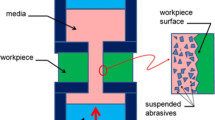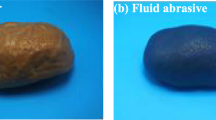Abstract
Flow field simulation of abrasive media in a constrained passage in abrasive flow machining (AFM) plays a decisive role in optimising process parameters and designing the core of a fixture. Based on the experimental rheological characterisation of various types of abrasive media, a model of flow field simulation of abrasive media was constructed by combining with the continuous medium hypothesis. Moreover, a pressure detection platform was built for the constrained passage and test and simulated data were compared and analysed. The results demonstrate that the diameter of abrasives slightly affects the rheological characterisation of abrasive media under the same mass fraction, and rheological characterisation of abrasive media before and after use obeys a power-law constitutive model. Simulated pressures in the flow field show a completely consistent trend with measured pressures although they deviate significantly in the inlet region. Pressure in the constrained passage increases with increasing extrusion pressure and gradually attenuates along the flow direction, so that abrasive finishing marks become shallower along the flow direction. In addition, the increased extrusion pressure increases the final surface roughness of the polished surface and extends the processing time required to stabilise the final surface quality.




















Similar content being viewed by others
References
Fu YZ, Gao H, Wang XP, Guo DM (2017) Machining the integral impeller and blisk of aero-engines: a review of surface finishing and strengthening technologies. Chin J Mech Eng 30(3):528–543. https://doi.org/10.1007/s10033-017-0123-3
Tan DP, Ji SM, Fu YZ (2016) An improved soft abrasive flow finishing method based on fluid collision theory. Int J Adv Manuf Technol 85(5–8):1261–1274. https://doi.org/10.1007/s00170-015-8044-8
Qi H, Cheng ZC, Cai DH, Yin LZ, Wang ZW, Wen DH (2018) Experimental study on the improvement of surface integrity of tungsten steel using acoustic levitation polishing. J Mater Process Technol 259:361–367. https://doi.org/10.1016/j.jmatprotec.2018.04.043
Tyagi P, GouletI T, Riso C, Garcia-Moreno F (2019) Reducing surface roughness by chemical polishing of additively manufactured 3D printed 316 stainless steel components. Int J Adv Manuf Technol 100:2895–2900. https://doi.org/10.1007/s00170-018-2890-0
Qi H, Xie Z, Hong T, Wang YY, Kong FZ, Wen DH (2017) CFD modelling of a novel hydrodynamic suspension polishing process for ultra-smooth surface with low residual stress. Powder Technol 317:320–328. https://doi.org/10.1016/j.powtec.2017.05.030
Peng C, Fu YZ, Wei HB, Li SC, Wang XP, Gao H (2018) Study on improvement of surface roughness and induced residual stress for additively manufactured metal parts by abrasive flow machining. Procedia CIRP 71:386–389. https://doi.org/10.1016/j.procir.2018.05.046
Petare AC, Jain NK (2018) On simultaneous improvement of wear characteristics, surface finish and microgeometry of straight bevel gears by abrasive flow finishing process. Wear 404:38–49. https://doi.org/10.1016/j.wear.2018.03.002
Howard MJ, Cheng K (2014) Energy and resource efficiency in the abrasive flow machining process: an assessment of environmental and economic viability within a UK precision machining SME. ASME 2014 International Design Engineering Technical Conferences and Computers and Information in Engineering Conference, V004T06A051. https://doi.org/10.1115/DETC2014-34110
Sushil M, Vinod K, Harmesh K (2015) Experimental investigation and optimization of process parameters of Al/SiC MMCs finished by abrasive flow machining. Mater Manuf Process 30(7):902–911. https://doi.org/10.1080/10426914.2015.1004704
Duval-Chaneac MS, Han S, Claudin C, Salvatore F, Bajolet J, Rech J (2018) Experimental study on finishing of internal laser melting (SLM) surface with abrasive flow machining (AFM). Precis Eng 54:1–6. https://doi.org/10.1016/j.precisioneng.2018.03.006
Singh S, Shan HS, Kumar P (2008) Experimental studies on mechanism of material removal in abrasive flow machining process. Mater Manuf Process 23(7):714–718. https://doi.org/10.1080/10426910802317110
Jain VK, Adsul SG (2000) Experimental investigations into abrasive flow machining (AFM). Int J Mach Tools Manuf 40(7):1003–1021. https://doi.org/10.1016/S0890-6955(99)00114-5
Sankar MR, Jain VK, Ramkumar J, Sareen SK, Singh S (2019) Medium rheological characterization and performance study during rotational abrasive flow finishing (R-AFF) of Al alloy and Al alloy/SiC MMCs. Int J Adv Manuf Technol 100(5–8):1149–1163. https://doi.org/10.1007/s00170-018-2244-y
Wang AC, Cheng KC, Chen KY, Lin YC (2014) Enhancing the surface precision for the helical passageways in abrasive flow machining. Mater Manuf Process 29(2):153–159. https://doi.org/10.1080/10426914.2013.852204
Wang AC, Lung T, Liang KZ, Liu CH, Weng SH (2009) Uniform surface polished method of complex holes in abrasive flow machining. T Nonferr Metal Soc 19:s250–s257. https://doi.org/10.1016/S1003-6326(10)60279-8
Howard M, Cheng K (2013) An industrially feasible approach to process optimisation of abrasive flow machining and its implementation perspectives. Proc Inst Mech Eng Part B: J Eng Manuf 227(11):1748–1752. https://doi.org/10.1177/0954405413491957
Uhlmann E, Schmiedel C, Wendler J (2015) CFD simulation of the abrasive flow machining process. Procedia CIRP 31:209–214. https://doi.org/10.1016/j.procir.2015.03.091
Fu YZ, Wang XP, Gao H, Wei HB, Li SC (2016) Blade surface uniformity of blisk finished by abrasive flow machining. Int J Adv Manuf Technol 84(5–8):1725–1735. https://doi.org/10.1007/s00170-015-8270-0
Wei HB, Gao H, Wang XY (2019) Development of novel guar gum hydrogel based media for abrasive flow machining: shear-thickening behavior and finishing performance. Int J Mech Sci 157:758–772. https://doi.org/10.1016/j.ijmecsci.2019.05.022
Shao Y, Cheng K (2019) Integrated modelling and analysis of micro-cutting mechanics with the precision surface generation in abrasive flow machining. Int J Adv Manuf Technol:1–13. https://doi.org/10.1007/s00170-019-03595-4
Sen S, Zhu W, Aitken BG (2017) Behavior of a supercooled chalcogenide liquid in the non-Newtonian regime under steady vs. oscillatory shear. J Chem Phys 147(3):034503. https://doi.org/10.1063/1.4993780
Fu SY, Feng XQ, Lauke B, Mai YW (2008) Effects of particle size, particle/matrix interface adhesion and particle loading on mechanical properties of particulate-polymer composites. Compos Part B-Eng 39(6):933–961. https://doi.org/10.1016/j.compositesb.2008.01.002
Hojjat M, Etemad SG, Bagheri R, Thibault J (2011) Rheological characteristics of non-Newtonian nanofluids: experimental investigation. Int J Heat Mass Transf 38(2):144–148. https://doi.org/10.1016/j.icheatmasstransfer.2010.11.019
Wan S, Ang YJ, Sato T, Lim GC (2014) Process modeling and CFD simulation of two-way abrasive flow machining. Int J Adv Manuf Technol 71(5-8):1077–1086. https://doi.org/10.1007/s00170-013-5550-4
Rudman M, Blackburn HM (2006) Direct numerical simulation of turbulent non-Newtonian flow using a spectral element method. Appl Math Model 30(11):1229–1248. https://doi.org/10.1016/j.apm.2006.03.005
Perona P (2003) An experimental investigation of laminar–turbulent transition in complex fluids. J Food Eng 60(2):137–145. https://doi.org/10.1016/S0260-8774(03)00027-X
Achiamah-Ampomah N, Cheng K (2016) Investigation on multi-physics simulation-based virtual machining system for vibratory finishing of integrally bladed rotors (IBRS). J Multiscale Model 7(01):1640003. https://doi.org/10.1142/S1756973716400035
Acknowledgements
The authors appreciate the anonymous reviewers for their constructive comments and suggestions.
Funding
This work was supported by the Guangdong Basic and Applied Basic Research Foundation (Grant No. 2019A1515010720), NSFC-Guangdong Joint Fund Project (Grant No. U1801259), Creative Research Groups of NSFC (Grant No. 51621064), National Natural Science Foundation of China (Grant No. U1708256), and Fundamental Research Funds for the Central Universities (Grant Nos. DUT17ZD201, DUT18GF104).
Author information
Authors and Affiliations
Corresponding authors
Ethics declarations
All authors have been personally and actively involved in substantive work leading to the report, and will hold themselves jointly and individually responsible for its content.
Conflict of interest
The authors declare that they have no conflict of interest.
Additional information
Publisher’s note
Springer Nature remains neutral with regard to jurisdictional claims in published maps and institutional affiliations.
The material has not been published in whole or in part elsewhere. The paper is not currently being considered for publication elsewhere.
Rights and permissions
About this article
Cite this article
Fu, Y., Gao, H., Yan, Q. et al. Rheological characterisation of abrasive media and finishing behaviours in abrasive flow machining. Int J Adv Manuf Technol 107, 3569–3580 (2020). https://doi.org/10.1007/s00170-020-05288-9
Received:
Accepted:
Published:
Issue Date:
DOI: https://doi.org/10.1007/s00170-020-05288-9




